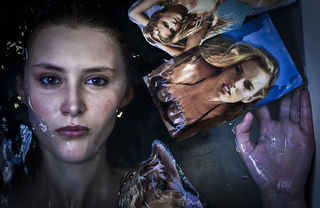Cognitive Behavioral Therapy
10 Faulty Thoughts That Occur in Body Dysmorphic Disorder
The secret life of a person with BDD.
Posted September 18, 2017 Reviewed by Ekua Hagan
Body dysmorphic disorder (BDD) is characterized by a persistent obsession with a perceived flaw in one's physical appearance. Normal appearance concerns become an obsession and begin to interfere with a person’s life.
BDD is now classified within the DSM-5 Obsessive-Compulsive and Related Disorders grouping (Fang and Wilhelm, 2015). Like other medical problems, BDD ranges from relatively mild to more severe.
People with BDD can dislike any part of their body (e.g., hair, skin, nose, chest, or stomach). In reality, a perceived defect may be only a slight imperfection or something other people don’t particularly notice. But for someone with BDD, the flaw is significant and prominent, often causing severe emotional pain that interferes with their life. The “flaws” are more in their minds than their bodies.
The following thoughts describe the most common distortions that afflict individuals with BDD. Cognitive-behavioral therapy aims to change these types of thoughts (Jefferies-Sewell, et al., 2017).
- Imagined ugliness. Individuals with BDD are completely convinced that their appearance flaws are real, and they believe that they look ugly, or deformed in some way when in fact they do not. As a consequence of this belief, approximately 27 to 76.4 percent of individuals with BDD seek cosmetic solutions for their concerns, including surgical, dermatological, and dental procedures (Phillips, 2005). These procedures are usually not beneficial.
- Excessive focus. Individuals with BDD overfocus on tiny details of their appearance rather than the “big picture” of how they look. They act as if they are being stared through binoculars. The excessive self-focus prevents them to see other aspects of their appearance (Phillips, 2005).
- Aesthetic sensitivity. Individuals with BDD believe that their appearance is highly important (Neziroglu, et al., 2008). They confuse attractiveness with happiness, e.g., “I can only be happy if my appearance improves."
- "They are making fun of how I look." This bias is known as referential thinking. Referential thinking consists of a false belief that other people take special notice of the imagined defect, e.g., “I am convinced that person is staring at my fat body."
- Intrusive thoughts. Individuals with BDD experience intrusive thoughts and/or images. They think about their real or perceived flaws for hours each day. They feel powerless over them. And they don't believe people who tell them that they look fine. They view themselves in terms of their imperfect appearance and assume that others must be doing the same.
- Impulse control. Patients with BDD exhibit poor impulse control, e.g., being unable to resist the urge to undertake cosmetic surgery to "correct" perceived flaws.
- BDD by proxy. They also excessively worry about other persons’ appearances, e.g., spouse, child, or sibling.
- Appearance comparison. Individuals with BDD frequently and silently compare their specific body parts with those of others (e.g., a more attractive sibling), often concluding that they are less attractive (Neziroglu, et al., 2008). The comparisons are associated with more body dissatisfaction, particularly if the comparison is made to target persons who are considered more attractive.
- Safety-seeking behaviors. When they are physically close to a person who is perceived as more attractive, BDD individuals are more likely to resort to a safety-seeking, protective behavior, such as camouflaging the perceived defect, avoiding eye contact, or escaping the situation (Fang and Wilhelm, 2015).
- Suffering in secret. BDD is often described as a silent disorder. In fact, patients with BDD often are too embarrassed to reveal their concern to anyone, or to seek psychiatric treatment for their appearance concerns. They may be concerned that others might consider them vain (Fang and Wilhelm, 2015).

Cognitive-behavioral therapy (CBT) teaches patients to recognize irrational thoughts and change negative thinking patterns. Cognitive therapy emphasizes the need to broaden the basis of their self-worth to include factors other than appearance (e.g., talents, intelligence, moral values). For example, they learn to observe and describe their appearance in a mindful, holistic, and nonjudgmental manner (Wilhelm et al 2013).
References
Fang A, Wilhelm S. (2015) Clinical Features, Cognitive Biases, and Treatment of Body Dysmorphic Disorder Annual Review of Clinical Psychology 11:187-212.
Jefferies-Sewell K, et al., (2017), Cognitive dysfunction in Body Dysmorphic Disorder: New implications for nosological systems & neurobiological models CNS Spectr. 2017 Feb; 22(1): 51–60.
Neziroglu, F., Khemlani-Patel, S., & Veale, D.(2008) Social learning theory and cognitive behavioral models of body dysmorphic disorder. Body Image, 5, 28-38.
Phillips KA (2005). The Broken Mirror: Understanding and Treating Body Dysmorphic Disorder, New York: Oxford University Press
Wilhelm S, Phillips KA, Steketee G. (2013). Cognitive-Behavioral Therapy for Body Dysmorphic Disorder: A Treatment Manual, New York: The Guilford Press.


